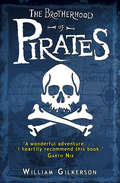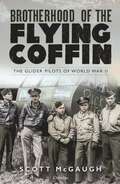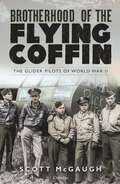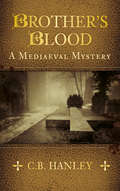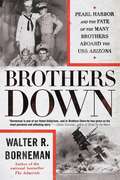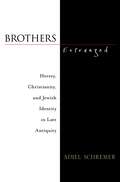- Table View
- List View
The Brotherhood of Freemason Sisters: Gender, Secrecy, and Fraternity in Italian Masonic Lodges
by Lilith MahmudFrom its traces in cryptic images on the dollar bill to Dan Brown’s The Lost Symbol, Freemasonry has long been one of the most romanticized secret societies in the world. But a simple fact escapes most depictions of this elite brotherhood: There are women Freemasons, too. In this groundbreaking ethnography, Lilith Mahmud takes readers inside Masonic lodges in contemporary Italy, where she observes the many ritualistic and fraternal bonds forged among women initiates of this elite and esoteric society. Offering a tantalizing look behind lodge doors, The Brotherhood of Freemason Sisters unveils a complex culture of discretion in which Freemasons simultaneously reveal some truths and hide others. Women—one of Freemasonry’s best-kept secrets—are often upper class and highly educated but paradoxically antifeminist, and their self-cultivation through the Masonic path is an effort to embrace the deeply gendered ideals of fraternity. Mahmud unravels this contradiction at the heart of Freemasonry: how it was at once responsible for many of the egalitarian concepts of the Enlightenment and yet has always been, and in Italy still remains, extremely exclusive. The result is not only a thrilling look at an unfamiliar—and surprisingly influential—world, but a reevaluation altogether of the modern values and ideals that we now take for granted.
The Brotherhood of Freemason Sisters: Gender, Secrecy, and Fraternity in Italian Masonic Lodges
by Lilith MahmudFrom its traces in cryptic images on the dollar bill to Dan Brown’s The Lost Symbol, Freemasonry has long been one of the most romanticized secret societies in the world. But a simple fact escapes most depictions of this elite brotherhood: There are women Freemasons, too. In this groundbreaking ethnography, Lilith Mahmud takes readers inside Masonic lodges in contemporary Italy, where she observes the many ritualistic and fraternal bonds forged among women initiates of this elite and esoteric society. Offering a tantalizing look behind lodge doors, The Brotherhood of Freemason Sisters unveils a complex culture of discretion in which Freemasons simultaneously reveal some truths and hide others. Women—one of Freemasonry’s best-kept secrets—are often upper class and highly educated but paradoxically antifeminist, and their self-cultivation through the Masonic path is an effort to embrace the deeply gendered ideals of fraternity. Mahmud unravels this contradiction at the heart of Freemasonry: how it was at once responsible for many of the egalitarian concepts of the Enlightenment and yet has always been, and in Italy still remains, extremely exclusive. The result is not only a thrilling look at an unfamiliar—and surprisingly influential—world, but a reevaluation altogether of the modern values and ideals that we now take for granted.
The Brotherhood of Freemason Sisters: Gender, Secrecy, and Fraternity in Italian Masonic Lodges
by Lilith MahmudFrom its traces in cryptic images on the dollar bill to Dan Brown’s The Lost Symbol, Freemasonry has long been one of the most romanticized secret societies in the world. But a simple fact escapes most depictions of this elite brotherhood: There are women Freemasons, too. In this groundbreaking ethnography, Lilith Mahmud takes readers inside Masonic lodges in contemporary Italy, where she observes the many ritualistic and fraternal bonds forged among women initiates of this elite and esoteric society. Offering a tantalizing look behind lodge doors, The Brotherhood of Freemason Sisters unveils a complex culture of discretion in which Freemasons simultaneously reveal some truths and hide others. Women—one of Freemasonry’s best-kept secrets—are often upper class and highly educated but paradoxically antifeminist, and their self-cultivation through the Masonic path is an effort to embrace the deeply gendered ideals of fraternity. Mahmud unravels this contradiction at the heart of Freemasonry: how it was at once responsible for many of the egalitarian concepts of the Enlightenment and yet has always been, and in Italy still remains, extremely exclusive. The result is not only a thrilling look at an unfamiliar—and surprisingly influential—world, but a reevaluation altogether of the modern values and ideals that we now take for granted.
The Brotherhood of Freemason Sisters: Gender, Secrecy, and Fraternity in Italian Masonic Lodges
by Lilith MahmudFrom its traces in cryptic images on the dollar bill to Dan Brown’s The Lost Symbol, Freemasonry has long been one of the most romanticized secret societies in the world. But a simple fact escapes most depictions of this elite brotherhood: There are women Freemasons, too. In this groundbreaking ethnography, Lilith Mahmud takes readers inside Masonic lodges in contemporary Italy, where she observes the many ritualistic and fraternal bonds forged among women initiates of this elite and esoteric society. Offering a tantalizing look behind lodge doors, The Brotherhood of Freemason Sisters unveils a complex culture of discretion in which Freemasons simultaneously reveal some truths and hide others. Women—one of Freemasonry’s best-kept secrets—are often upper class and highly educated but paradoxically antifeminist, and their self-cultivation through the Masonic path is an effort to embrace the deeply gendered ideals of fraternity. Mahmud unravels this contradiction at the heart of Freemasonry: how it was at once responsible for many of the egalitarian concepts of the Enlightenment and yet has always been, and in Italy still remains, extremely exclusive. The result is not only a thrilling look at an unfamiliar—and surprisingly influential—world, but a reevaluation altogether of the modern values and ideals that we now take for granted.
The Brotherhood of Freemason Sisters: Gender, Secrecy, and Fraternity in Italian Masonic Lodges
by Lilith MahmudFrom its traces in cryptic images on the dollar bill to Dan Brown’s The Lost Symbol, Freemasonry has long been one of the most romanticized secret societies in the world. But a simple fact escapes most depictions of this elite brotherhood: There are women Freemasons, too. In this groundbreaking ethnography, Lilith Mahmud takes readers inside Masonic lodges in contemporary Italy, where she observes the many ritualistic and fraternal bonds forged among women initiates of this elite and esoteric society. Offering a tantalizing look behind lodge doors, The Brotherhood of Freemason Sisters unveils a complex culture of discretion in which Freemasons simultaneously reveal some truths and hide others. Women—one of Freemasonry’s best-kept secrets—are often upper class and highly educated but paradoxically antifeminist, and their self-cultivation through the Masonic path is an effort to embrace the deeply gendered ideals of fraternity. Mahmud unravels this contradiction at the heart of Freemasonry: how it was at once responsible for many of the egalitarian concepts of the Enlightenment and yet has always been, and in Italy still remains, extremely exclusive. The result is not only a thrilling look at an unfamiliar—and surprisingly influential—world, but a reevaluation altogether of the modern values and ideals that we now take for granted.
Brotherhood of Kings: How International Relations Shaped the Ancient Near East
by Amanda H. PodanyAmanda Podany here takes readers on a vivid tour through a thousand years of ancient Near Eastern history, from 2300 to 1300 BCE, paying particular attention to the lively interactions that took place between the great kings of the day. Allowing them to speak in their own words, Podany reveals how these leaders and their ambassadors devised a remarkably sophisticated system of diplomacy and trade. What the kings forged, as they saw it, was a relationship of friends-brothers-across hundreds of miles. Over centuries they worked out ways for their ambassadors to travel safely to one another's capitals, they created formal rules of interaction and ways to work out disagreements, they agreed to treaties and abided by them, and their efforts had paid off with the exchange of luxury goods that each country wanted from the other. Tied to one another through peace treaties and powerful obligations, they were also often bound together as in-laws, as a result of marrying one another's daughters. These rulers had almost never met one another in person, but they felt a strong connection--a real brotherhood--which gradually made wars between them less common. Indeed, any one of the great powers of the time could have tried to take over the others through warfare, but diplomacy usually prevailed and provided a respite from bloodshed. Instead of fighting, the kings learned from one another, and cooperated in peace. A remarkable account of a pivotal moment in world history--the establishment of international diplomacy thousands of years before the United Nations--Brotherhood of Kings offers a vibrantly written history of the region often known as the "cradle of civilization."
Brotherhood of Kings: How International Relations Shaped the Ancient Near East
by Amanda H. PodanyAmanda Podany here takes readers on a vivid tour through a thousand years of ancient Near Eastern history, from 2300 to 1300 BCE, paying particular attention to the lively interactions that took place between the great kings of the day. Allowing them to speak in their own words, Podany reveals how these leaders and their ambassadors devised a remarkably sophisticated system of diplomacy and trade. What the kings forged, as they saw it, was a relationship of friends-brothers-across hundreds of miles. Over centuries they worked out ways for their ambassadors to travel safely to one another's capitals, they created formal rules of interaction and ways to work out disagreements, they agreed to treaties and abided by them, and their efforts had paid off with the exchange of luxury goods that each country wanted from the other. Tied to one another through peace treaties and powerful obligations, they were also often bound together as in-laws, as a result of marrying one another's daughters. These rulers had almost never met one another in person, but they felt a strong connection--a real brotherhood--which gradually made wars between them less common. Indeed, any one of the great powers of the time could have tried to take over the others through warfare, but diplomacy usually prevailed and provided a respite from bloodshed. Instead of fighting, the kings learned from one another, and cooperated in peace. A remarkable account of a pivotal moment in world history--the establishment of international diplomacy thousands of years before the United Nations--Brotherhood of Kings offers a vibrantly written history of the region often known as the "cradle of civilization."
The Brotherhood of Pirates
by William GilkersonIn 1952 off the coast of Nova Scotia, Canada, fierce winds force a small boat into port. The sailor of the boat is the eccentric Captain Charles Johnson, who then takes up residence at the small inn run by a young boy, Jim, and his mother. With each day, Captain Johnson becomes more and more valuable to the family and changes the fortunes of their previously struggling business. But it soon becomes clear that the stranger living in their midst is more than just a sailor. Who is this man who tells such vivid stories about sailing on a pirate ship? And how can he possibly know so much?
Brotherhood of the Flying Coffin: The Glider Pilots of World War II
by Scott McGaughThe first major history of the American glider pilots, the forgotten heroes of World War II, by New York Times bestselling author Scott McGaugh. A story of no guns, no engines and no second chances.This book distills war down to individual young men climbing into defenseless gliders made of plywood, ready to trust the towing aircraft that would pull them into enemy territory by a single cable wrapped with a telephone wire. Based on their after-action reports, journals, oral histories, photos and letters home, The Brotherhood of the Flying Coffin reveals every terrifying minute of their missions.They were all volunteers, for a specialized duty that their own government projected would have a 50 percent casualty rate. None faltered. In every major European invasion of the war they led the way. They landed their gliders ahead of the troops who stormed Omaha Beach, and sometimes miles ahead of the paratroopers bound for the far side of the Rhine River in Germany itself. From there, they had to hold their positions. They delivered medical teams, supplies and gasoline to troops surrounded in the Battle of the Bulge, ahead even of Patton's famous supply truck convoy. These all-volunteer glider pilots played a pivotal role in liberating the West from tyranny, from the day the Allies invaded Occupied Europe to the day Germany finally surrendered. Yet the story of these anonymous heroes is virtually unknown. Here their story is told in full – a story which epitomizes courage, dedication and sacrifice.
Brotherhood of the Flying Coffin: The Glider Pilots of World War II
by Scott McGaughThe first major history of the American glider pilots, the forgotten heroes of World War II, by New York Times bestselling author Scott McGaugh. A story of no guns, no engines and no second chances.This book distills war down to individual young men climbing into defenseless gliders made of plywood, ready to trust the towing aircraft that would pull them into enemy territory by a single cable wrapped with a telephone wire. Based on their after-action reports, journals, oral histories, photos and letters home, The Brotherhood of the Flying Coffin reveals every terrifying minute of their missions.They were all volunteers, for a specialized duty that their own government projected would have a 50 percent casualty rate. None faltered. In every major European invasion of the war they led the way. They landed their gliders ahead of the troops who stormed Omaha Beach, and sometimes miles ahead of the paratroopers bound for the far side of the Rhine River in Germany itself. From there, they had to hold their positions. They delivered medical teams, supplies and gasoline to troops surrounded in the Battle of the Bulge, ahead even of Patton's famous supply truck convoy. These all-volunteer glider pilots played a pivotal role in liberating the West from tyranny, from the day the Allies invaded Occupied Europe to the day Germany finally surrendered. Yet the story of these anonymous heroes is virtually unknown. Here their story is told in full – a story which epitomizes courage, dedication and sacrifice.
Brotherhoods of Color: Black Railroad Workers and the Struggle for Equality
by Eric ARNESENFrom the time the first tracks were laid in the early nineteenth century, the railroad has occupied a crucial place in America's historical imagination. Now, for the first time, Eric Arnesen gives us an untold piece of that vital American institution--the story of African Americans on the railroad. African Americans have been a part of the railroad from its inception, but today they are largely remembered as Pullman porters and track layers. The real history is far richer, a tale of endless struggle, perseverance, and partial victory. In a sweeping narrative, Arnesen re-creates the heroic efforts by black locomotive firemen, brakemen, porters, dining car waiters, and redcaps to fight a pervasive system of racism and job discrimination fostered by their employers, white co-workers, and the unions that legally represented them even while barring them from membership. Decades before the rise of the modern civil rights movement in the mid-1950s, black railroaders forged their own brand of civil rights activism, organizing their own associations, challenging white trade unions, and pursuing legal redress through state and federal courts. In recapturing black railroaders' voices, aspirations, and challenges, Arnesen helps to recast the history of black protest and American labor in the twentieth century.Table of Contents: Prologue 1. Race in the First Century of American Railroading 2. Promise and Failure in the World War I Era 3. The Black Wedge of Civil Rights Unionism 4. Independent Black Unionism in Depression and War 5. The Rise of the Red Caps 6. The Politics of Fair Employment 7. The Politics of Fair Representation 8. Black Railroaders in the Modern Era Conclusion Notes Acknowledgments Index Reviews of this book: In this superbly written monograph, Arnesen...shows how African American railroad workers combined civil rights and labor union activism in their struggles for racial equality in the workplace...Throughout, black locomotive firemen, porters, yardmen, and other railroaders speak eloquently about the work they performed and their confrontations with racist treatment...This history of the 'aristocrats' of the African American working class is highly recommended.--Charles L. Lumpkins, Library JournalReviews of this book: Arnesen provides a fascinating look at U.S. labor and commerce in the arena of the railroads, so much a part of romantic notions about the growth of the nation. The focus of the book is the troubled history of the railroads in the exploitation of black workers from slavery until the civil rights movement, with an insightful analysis of the broader racial integration brought about by labor activism.--Vanessa Bush, BooklistReviews of this book: [An] exhaustive and illuminating work of scholarship.--Publishers WeeklyReviews of this book: Arnesen tells a story that should be of interest to a variety of readers, including those who are avid students of this country's railroads. He knows his stuff, and furthermore, reminds us of how dependent American railroads were on the backbreaking labor of racial and ethnic groups whose civil and political status were precarious at best: Irish, Chinese, Mexicans and Italians, as well as African-Americans. But Arnesen's most powerful and provocative argument is that the nature of discrimination not only led black railroad workers to pursue the path of independent unionism, it also propelled them into the larger struggle for civil rights.--Steven Hahn, Chicago Tribune
Brotherless Night: Winner of the Women’s Prize for Fiction 2024
by V. V. Ganeshananthan'A masterpiece of historical fiction.' MONICA ALI, chair of judges for the Women's Prize for Fiction WINNER OF THE WOMEN'S PRIZE FOR FICTION 2024WINNER OF THE CAROL SHIELDS PRIZE FOR FICTION"A heart-breaking exploration of a family fractured by civil war. This beautiful, nuanced novel follows a young doctor caught within conflicting ideologies as she tries to save lives. I couldn't put this book down" BRIT BENNETT, bestselling author of THE VANISHING HALF Sixteen-year-old Sashi wants to become a doctor. But over the next decade, as a vicious civil war subsumes Sri Lanka, her dream takes her on a different path as she watches those around her, including her four beloved brothers and their best friend, get swept up in violent political ideologies and their consequences. She must ask herself: is it possible for anyone to move through life without doing harm? "With immense compassion and deep moral complexity, V. V. Ganeshananthan brings us an achingly moving portrait of individual and societal grief' CELESTE NG, bestselling author of LITTLE FIRES EVERYWHERE"Stunningly great" Curtis Sittenfeld, bestselling author of ROMANTIC COMEDY, via Twitter"Ganeshananthan is a superb writer...I wept at many points in this novel and I also wept when it was over" Sunday Times
Brotherly Love: Freemasonry and Male Friendship in Enlightenment France
by Kenneth B. LoiselleFriendship, an acquired relationship primarily based on choice rather than birth, lay at the heart of Enlightenment preoccupations with sociability and the formation of the private sphere. In Brotherly Love, Kenneth Loiselle argues that Freemasonry is an ideal arena in which to explore the changing nature of male friendship in Enlightenment France. Freemasonry was the largest and most diverse voluntary organization in the decades before the French Revolution. At least fifty thousand Frenchmen joined lodges, the memberships of which ranged across the social spectrum from skilled artisans to the highest ranks of the nobility. Loiselle argues that men were attracted to Freemasonry because it enabled them to cultivate enduring friendships that were egalitarian and grounded in emotion.Drawing on scores of archives, including private letters, rituals, the minutes of lodge meetings, and the speeches of many Freemasons, Loiselle reveals the thought processes of the visionaries who founded this movement, the ways in which its members maintained friendships both within and beyond the lodge, and the seemingly paradoxical place women occupied within this friendship community. Masonic friendship endured into the tumultuous revolutionary era, although the revolutionary leadership suppressed most of the lodges by 1794. Loiselle not only examines the place of friendship in eighteenth-century society and culture but also contributes to the history of emotions and masculinity, and the essential debate over the relationship between the Enlightenment and the French Revolution.
Brothers Across the Ocean: British Foreign Policy and the Origins of the Anglo-American 'special Relationship' 1900-1905
by Iestyn Adams Lestyn AdamsThe 'Special Relationship' has long been a leading feature of ties between the USA and Britain, but never has it been more topical than now, following wars in Iraq and Afghanistan. 'Brothers Across the Ocean' is a unique and revealing investigation into this relationship's early history, vital to understanding its current incarnations, focusing on the period when Britain's role as a leading global power began to be rivalled - possibly eclipsed - by the rising star of the USA. Based on detailed examination of official and private papers, Iestyn Adams shows how Anglo-American diplomacy operated across the world, from South America to Hawaii, from Canada to the Far East. Adams argues it was in the Far East that the leading example of Anglo-American cooperation played out, through the Russo-Japanese War - a conflict of global importance that set the stage for a relationship that has endured into the twenty-first century. This insightful study is a valuable resource for scholars of Modern History and International Relations.
Brothers Among Nations: The Pursuit of Intercultural Alliances in Early America, 1580-1660
by Cynthia J. Van ZandtDuring the first eighty years of permanent European colonization, webs of alliances shaped North America from northern New England to the Outer Banks of North Carolina and entangled all peoples in one form or another. In Brothers among Nations, Cynthia Van Zandt argues that the pursuit of alliances was a widespread multiethnic quest that shaped the early colonial American world in fundamentally important ways. These alliances could produce surprising results, with Europeans sometimes subservient to more powerful Native American nations, even as native nations were sometimes clients and tributaries of European colonists. Spanning nine European colonies, including English, Dutch, and Swedish colonies, as well as many Native American nations and a community of transplanted Africans, Brothers among Nations enlists a broad array of sources to illuminate the degree to which European colonists were frequently among the most vulnerable people in North America and the centrality of Native Americans to the success of the European colonial project.
Brothers Among Nations: The Pursuit of Intercultural Alliances in Early America, 1580-1660
by Cynthia J. Van ZandtDuring the first eighty years of permanent European colonization, webs of alliances shaped North America from northern New England to the Outer Banks of North Carolina and entangled all peoples in one form or another. In Brothers among Nations, Cynthia Van Zandt argues that the pursuit of alliances was a widespread multiethnic quest that shaped the early colonial American world in fundamentally important ways. These alliances could produce surprising results, with Europeans sometimes subservient to more powerful Native American nations, even as native nations were sometimes clients and tributaries of European colonists. Spanning nine European colonies, including English, Dutch, and Swedish colonies, as well as many Native American nations and a community of transplanted Africans, Brothers among Nations enlists a broad array of sources to illuminate the degree to which European colonists were frequently among the most vulnerable people in North America and the centrality of Native Americans to the success of the European colonial project.
Brothers Apart: Palestinian Citizens of Israel and the Arab World (Stanford Studies in Middle Eastern and Islamic Societies and Cultures)
by Maha NassarWhen the state of Israel was established in 1948, not all Palestinians became refugees: some stayed behind and were soon granted citizenship. Those who remained, however, were relegated to second-class status in this new country, controlled by a military regime that restricted their movement and political expression. For two decades, Palestinian citizens of Israel were cut off from friends and relatives on the other side of the Green Line, as well as from the broader Arab world. Yet they were not passive in the face of this profound isolation. Palestinian intellectuals, party organizers, and cultural producers in Israel turned to the written word. Through writers like Mahmoud Darwish and Samih al-Qasim, poetry, journalism, fiction, and nonfiction became sites of resistance and connection alike. With this book, Maha Nassar examines their well-known poetry and uncovers prose works that have, until now, been largely overlooked. The writings of Palestinians in Israel played a key role in fostering a shared national consciousness and would become a central means of alerting Arabs in the region to the conditions—and to the defiance—of these isolated Palestinians. Brothers Apart is the first book to reveal how Palestinian intellectuals forged transnational connections through written texts and engaged with contemporaneous decolonization movements throughout the Arab world, challenging both Israeli policies and their own cultural isolation. Maha Nassar reexamines these intellectuals as the subjects, not objects, of their own history and brings to life their perspectives on a fraught political environment. Her readings not only deprovincialize the Palestinians of Israel, but write them back into Palestinian, Arab, and global history.
Brother's Blood: A Mediaeval Mystery (Book 4) (Mediaeval Mystery Ser. #4)
by C.B. Hanley1217: The war for the throne of England is far from over but as commoner-turned-earl’s-man Edwin Weaver waits to see where his lord’s loyalties lie, a messenger arrives from Roche Abbey: one of the monks has been murdered. The abbot needs help to find the killer and Edwin soon finds himself within the unfamiliar and claustrophobic confines of the abbey, where faces are hidden and a killer stalks unnoticed. Drawn ever deeper into a web of lies and deceit, Edwin not only has to discover the identity of the murderer, but must also decide where his real duty lies. The fourth book in C.B. Hanley’s popular Mediaeval Mystery series, following Whited Sepulchres.
The Brothers Boswell
by Philip Baruth30th July, 1763. Two striking figures part the heaving crowd at London Bridge. Peddlers cease their haggling, ferrymen grow quiet, beggars stop and stare. Even the stink of the Thames seems to fade in the presence of Dr Samuel Johnson and James Boswell - history's most famous friends. Boswell, as charismatic and meticulously coiffed as Johnson is bullish and badly dressed, is eager to advance himself in literary society. Today he is to accompany the great Dr Johnson on an excursion up the Thames - and he is determined that nothing will go wrong. But another Boswell is watching from the shadows, insanely jealous of his elder brother's meteoric rise through London's coffeehouses and whorehouses, tenements and theatres, soirees and salons. He has two golden pistols in his pocket, a ferryboat at his disposal... and murder in his heart.
Brothers Down: Pearl Harbor and the Fate of the Many Brothers Aboard the USS Arizona
by Walter R. BornemanA deeply personal and never-before-told account of one of America's darkest days, from the bestselling author of The Admirals and MacArthur at War.The surprise attack at Pearl Harbor on December 7, 1941 remains one of the most traumatic events in American history. America's battleship fleet was crippled, thousands of lives were lost, and the United States was propelled into a world war. Few realize that aboard the iconic, ill-fated USS Arizona were an incredible seventy-nine blood relatives. Tragically, in an era when family members serving together was an accepted, even encouraged, practice, sixty-three of the Arizona's 1,177 dead turned out to be brothers.In Brothers Down, acclaimed historian Walter R. Borneman returns to that critical week of December, masterfully guiding us on an unforgettable journey of sacrifice and heroism, all told through the lives of these brothers and their fateful experience on the Arizona. Weaving in the heartbreaking stories of the parents, wives, and sweethearts who wrote to and worried about these men, Borneman draws from a treasure trove of unpublished source material to bring to vivid life the minor decisions that became a matter of life or death when the bombs began to fall. More than just an account of familial bonds and national heartbreak, what emerges promises to define a turning point in American military history.
Brothers Down: Pearl Harbor and the Fate of the Many Brothers Aboard the USS Arizona
by Walter R. BornemanA deeply personal and never-before-told account of one of America's darkest days, from the bestselling author of The Admirals and MacArthur at War. The surprise attack at Pearl Harbor on December 7, 1941 remains one of the most traumatic events in American history. America's battleship fleet was crippled, thousands of lives were lost, and the United States was propelled into a world war. Few realize that aboard the iconic, ill-fated USS Arizona were an incredible seventy-nine blood relatives. Tragically, in an era when family members serving together was an accepted, even encouraged, practice, sixty-three of the Arizona's 1,177 dead turned out to be brothers. In Brothers Down, acclaimed historian Walter R. Borneman returns to that critical week of December, masterfully guiding us on an unforgettable journey of sacrifice and heroism, all told through the lives of these brothers and their fateful experience on the Arizona. Weaving in the heartbreaking stories of the parents, wives, and sweethearts who wrote to and worried about these men, Borneman draws from a treasure trove of unpublished source material to bring to vivid life the minor decisions that became a matter of life or death when the bombs began to fall. More than just an account of familial bonds and national heartbreak, what emerges promises to define a turning point in American military history.
Brothers Estranged: Heresy, Christianity and Jewish Identity in Late Antiquity
by Adiel SchremerThe emergence of formative Judaism has traditionally been examined in light of a theological preoccupation with the two competing religious movements, 'Christianity' and 'Judaism' in the first centuries of the Common Era. In this book Ariel Schremer attempts to shift the scholarly consensus away from this paradigm, instead privileging the rabbinic attitude toward Rome, the destroyer of the temple in 70 C.E., over their concern with the nascent Christian movement. The palpable rabbinic political enmity toward Rome, says Schremer, was determinative in the emerging construction of Jewish self-identity. He asserts that the category of heresy took on a new urgency in the wake of the trauma of the Temple's destruction, which demanded the construction of a new self-identity. Relying on the late 20th-century scholarly depiction of the slow and measured growth of Christianity in the empire up until and even after Constantine's conversion, Schremer minimizes the extent to which the rabbis paid attention to the Christian presence. He goes on, however, to pinpoint the parting of the ways between the rabbis and the Christians in the first third of the second century, when Christians were finally assigned to the category of heretics.
Brothers Estranged: Heresy, Christianity and Jewish Identity in Late Antiquity
by Adiel SchremerThe emergence of formative Judaism has traditionally been examined in light of a theological preoccupation with the two competing religious movements, 'Christianity' and 'Judaism' in the first centuries of the Common Era. In this book Ariel Schremer attempts to shift the scholarly consensus away from this paradigm, instead privileging the rabbinic attitude toward Rome, the destroyer of the temple in 70 C.E., over their concern with the nascent Christian movement. The palpable rabbinic political enmity toward Rome, says Schremer, was determinative in the emerging construction of Jewish self-identity. He asserts that the category of heresy took on a new urgency in the wake of the trauma of the Temple's destruction, which demanded the construction of a new self-identity. Relying on the late 20th-century scholarly depiction of the slow and measured growth of Christianity in the empire up until and even after Constantine's conversion, Schremer minimizes the extent to which the rabbis paid attention to the Christian presence. He goes on, however, to pinpoint the parting of the ways between the rabbis and the Christians in the first third of the second century, when Christians were finally assigned to the category of heretics.
Brothers Forever: The Enduring Bond between a Marine and a Navy SEAL that Transcended Their Ultimate Sacrifice
by Tom Sileo Tom ManionRecounts the personal story of how two Naval academy roommates--US Marine Travis Manion and US Navy SEAL Brendan Looney--defined a generation's sacrifice after 9/11, and how their loved ones carry on in their memory Four weeks after Navy SEALs had killed Osama bin Laden, the President of the United States stood in Arlington National Cemetery. In his Memorial Day address, he extolled the courage and sacrifice of the two young men buried side by side in the graves before him: Travis Manion, a fallen US Marine, and Brendan Looney, a fallen US Navy SEAL. Although they were killed three years apart, one in Iraq and one in Afghanistan, these two best friends and former roommates were now buried together--"brothers forever."Award-winning journalist Tom Sileo and Travis's father, former Marine colonel Tom Manion, come together to tell thisd intimate story, from Travis's incredible heroism on the streets of Fallujah to Brendan's anguished Navy SEAL training in the wake of his friend's death and his own heroism in the mountains of Afghanistan. Brothers Forever is a remarkable story of friendship, family, and war.
Brothers' Fury: (Civil War: 2): a thrilling novel of tragic family turmoil and brutal civil war that will blow you away (The Bleeding Land #2)
by Giles KristianRebel Tom Rivers has been rejected by both his family and his commanding officer. But spymaster Captain Crafte sees in the young hothead a fearlessness that could be used to strike at the very heart of the Royalist cause. Renegade Raw with grief at the death of his father, Edmund Rivers has rejected the peace talks between Parliament and the King. Now he leads a band of ruthless marauders against the rebels. However, Prince Rupert, recognising a kindred spirit, has other, no less daring plans. Huntress Heart broken by the deaths that surround her, Bess Rivers bravely leaves her infant son and Sheer House to go in search of the one person who might help her douse the flames of her brothers’ fury. . .The second novel in Giles' acclaimed Bleeding Land series, Brothers’ Fury is a powerful and thrilling novel of family turmoil and civil war.


